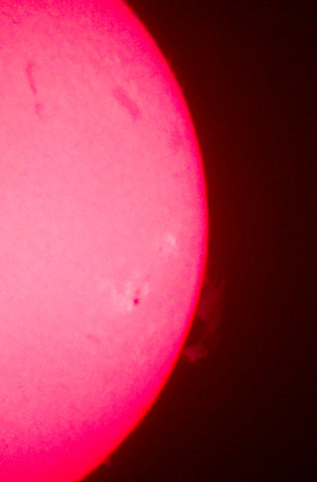Solar observers were enchanted by a beautiful prominence appearance last week. The picture underneath was taken through a small 4cm H-alpha telescope on 9 May at 8:24UT, just hours before the prominence spectacularly erupted (movie).

Interestingly, the prominence was not near the west limb, but already well on the backside of the Sun. It had crossed the west limb on 7 May, so it was about 16-25° behind the west limb on 9 May as seen from Earth (green in top-view sketch underneath). The prominence was approaching the central meridian of STEREO-A's view of the solar disk (red in sketch; filament indicated by red-dashed line), and it was already visible from behind STEREO-B's east limb (blue in sketch)! This all meant that its true height was somewhat higher than its apparent size as seen from Earth. Preliminary results indicate that the prominence, prior to its eruption, had an apparent height of about 70.000km (over the west limb), but was in reality towering at least 100.000km over the solar surface. That's the equivalent of 8 earth diameters!

The evolution in H-alpha shows that this area was initially not very active, with opposite magnetic fields holding little material. As a result, the filaments were not well visible during the first few days of May. This changed on 6 May, as the filament started to grow, packing more material. This resulted in the very nice prominence that could be seen starting 7 May. Combo movies in various wavelengths show that the ejected material consisted mainly of relatively cool matter, i.e. much cooler than the typical 1 million degree temperatures that reign in the corona. See this movie.

As the magnetic field became unstable during the afternoon of 9 May, an eruption occurred. This resulted in a solid coronal mass ejection (CME) which was directed away from Earth and to the south, as the STEREO and SOHO movies show. The two bright dots in SOHO/LASCO's field of view are Mercury (left) and Mars (right). Both planets are on the other side of the Sun.
The EUV and coronagraph clips are covering 9 and 10 May, and show some other eruptions too such as near the Sun's south pole (noon 9 May) and another spectacular eruption in the evening hours of 10 May, which was central in STEREO-A's field of view and seems to have originated in old active region NOAA 1731.

Credits - Data and imagery for the movie clips were taken from the GONG H-alpha network, SDO, STEREO, and SOHO/LASCO.
 |
 |





